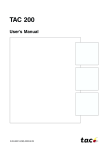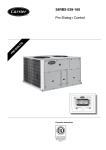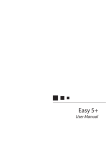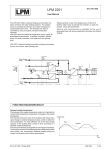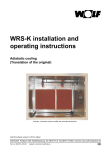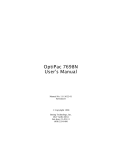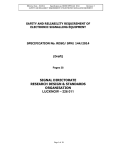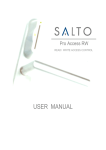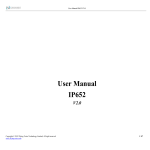Download TAC 200 OTP Compensator and optimiser
Transcript
TAC 200 OTP Compensator and optimiser Handbook 0-004-1400-0 (SE), 2000-02-08 TAC 200 OTP Handbook Contents TAC 200 OTP Handbook This document contains proprietary information of TAC AB and is made available solely to those who operate and maintain Tour & Andersson equipment. Disclosure, reproduction or use of either the documents or the information contained herein for any other purpose is strictly prohibited. TAC AB reserves the right to make changes or additions to material as necessary. © 1994 TAC AB Contents 1 Introduction 1.1 TAC 200 OTP compensator and optimiser ............................................................................. 1:1 1.2 This manual .............................................................................................................................. 1:1 1.3 More information ..................................................................................................................... 1:2 2 General 2.1 2.2 2.3 2.4 3 Mounting .................................................................................................................................. 2:1 Connections .............................................................................................................................. 2:3 Operator’s panel ...................................................................................................................... 2:4 Commissioning ......................................................................................................................... 2:6 Daily operations, P:00–P:15 3.1 List of available functions ........................................................................................................ 3:1 3.2 Description ............................................................................................................................... 3:2 4 Special functions, P:16– 4.1 List of available functions ........................................................................................................ 4:1 4.2 Restart ...................................................................................................................................... 4:3 4.2.1 4.2.2 4.2.3 Returning to factory settings ......................................................................................................................... 4:3 Not returning to factory settings ................................................................................................................... 4:3 Power failure ................................................................................................................................................. 4:3 4.3 Control functions ...................................................................................................................... 4:4 4.4 Reset curve ................................................................................................................................ 4:5 4.4.1 Supply water temperature controller ............................................................................................................ 4:7 4.5 Room temperature control ....................................................................................................... 4:8 4.5.1 4.5.2 System with a room sensor ........................................................................................................................... 4:8 System without a room sensor ...................................................................................................................... 4:8 4.6 Night setback and Morning boost ............................................................................................ 4:9 4.6.1 4.6.2 Night setback ................................................................................................................................................. 4:9 Morning boost ............................................................................................................................................... 4:9 4.7 Extended day/night operation ............................................................................................... 4:10 4.8 Start time optimisation ........................................................................................................... 4:11 TAC AB, Feb 2000 TAC 200 OTP Handbook Contents 4.9 Pump control .......................................................................................................................... 4:13 4.9.1 4.9.2 Pump cut off ................................................................................................................................................ 4:13 Pump exercise .............................................................................................................................................. 4:13 4.10Frost protection ...................................................................................................................... 4:14 4.11Time functions ........................................................................................................................ 4:15 4.11.1 Daylight saving time ................................................................................................................................... 4:15 4.12Test functions ......................................................................................................................... 4:16 4.12.1 Program version .......................................................................................................................................... 4:16 4.12.1 Relay outputs ............................................................................................................................................... 4:16 5 Technical data 5.1 Technical data .......................................................................................................................... 5:1 5.2 Factory settings ......................................................................................................................... 5:2 5.3 Part numbers ............................................................................................................................ 5:3 TAC 200 OTP Commissioning protocol This manual contains in all 21 leaves. TAC AB, Feb 2000 TAC 200 OTP Handbook Introduction 1 Introduction 1.1 TAC 200 OTP compensator and optimiser TAC 200 OTP is a compensator and an optimiser. It controls the heating via a boiler output and a mixing valve or via two stages of gas boilers. TAC 200 OTP can be operated with or without a room sensor. The controller has an easy-to-use operator’s panel and needs virtually no maintenance. 1.2 This manual This manual has the following content. Chapter 2 This chapter shows how TAC 200 OTP is mounted, connected and commissioned. There is also a description of the operator’s panel with its symbols. To show the use of the operating buttons, there is a detailed description of how to set the date and time. When the time has been set, TAC 200 OTP immediately starts controlling, using the factory settings. Chapter 3 This chapter describes the daily operations of TAC 200 OTP. You can read temperature values, enter setpoints and change the time program for day and night time operation. Chapter 4 When a plant is commissioned and fine-tuned, it may be necessary to adjust some of the parameters. The controller function and available parameters are described in chapter 4. Chapter 5 This is a summary of the technical data of TAC 200 OTP. There is also a list of all the factory settings used at a restart. At the end of the manual there is a commissioning protocol, where entered values should be noted. TAC AB, Feb 2000 1:1 TAC 200 OTP Handbook Introduction 1.3 More information TAC 200 OTP is also described in the following documents, all available in English : • Data sheet TAC 200 OTP C-10-31 The data sheet contains a comprehensive specification of the controller and should be read together with the handbook (part number 0-003-1148). • A brief instruction A small leaflet normally placed in a slot in the operator’s panel (part number 0FL-3564). • User’s manual TAC 200 OTP The user’s manual (part number 0FL-3563) is a description for installation and start-up, packed together with the unit. The contents are a condensed version of chapter 2 in this manual and a mounting instruction. 1:2 TAC AB, Feb 2000 TAC 200 OTP Handbook General 2 General 2.1 Mounting TAC 200 OTP controller TAC 200 OTP is encased in a plastic enclosure with a transparent cover. The controller can be mounted in three ways, either directly on the wall, on a DIN rail or in a panel. There are cable inlet holes on three sides. The controller is attached to the base and should be removed as shown below. Mount the base plate in an easily accessible position where the display is clearly legible. Connect the wires according to the wiring diagram. Screw the controller back onto the base plate. There are holes in the base plate for mounting the controller directly onto the wall if preferred. Separation of the controller from the base plate To mount the controller on a DIN rail, place the controller on the upper edge of the rail and press it inwards to snap it into place, see next page. To remove it again, place a screw driver in the red piece of plastic on the lower part of the controller, pull downwards and then pull the controller upwards from the rail. TAC AB, Feb 2000 2:1 TAC 200 OTP Handbook General Mounting of the controller on a DIN rail To mount the controller in a panel the space needs to be 138×92 mm. Place the controller in the panel and turn the small plastic hooks in the controller’s screw holes to secure it. Outdoor sensor EGU Mount the sensor on an external wall, facing north or north-west. The sensor should be placed about 3 m above ground level and the cable inlet should face downwards. Supply sensor EGWS/EGA The immersion sensor EGWS is mounted in the riser pipe, some 0,5–1 m downstream of the mixing valve. If an EGA strap-on sensor is used, it should be mounted on an uninsulated part of the pipe. Clean the pipe thoroughly so that the copper contact plate of the sensor makes good contact with the pipe. Room sensor EGRL To achieve the best performance, the following should be taken into consideration when mounting the room sensor: • The sensor should be installed in a room which is typical of the building. • The sensor should be placed on an inner wall of light building material. The wall must not be heated by, for example, uninsulated heating pipes behind it. • The room should be of sufficient size for the temperature not to be adversely affected by people or machinery. • The radiators of the room should not have thermostat valves. If they have they should be turned to the largest value possible. • The room sensor should be placed so that the air can flow freely around it. 2:2 TAC AB ,Feb 2000 TAC 200 OTP Handbook General • The room sensor should be placed within 10 m from the nearest radiator, but not right above it. Actuator (M44, M5, M15, M42) Mounting instructions are supplied with the actuator/mounting kit. 230 V/L 1 L M 10 230 V/N 2 N B1 11 Supply temp. sensor 3 PE B2 12 Outdoor sensor 4 KC1 B3 13 Room sensor 5 K1 M 14 6 K2 X1 15 7 KC2 X2 16 Pump 8 K3 X3 17 Boiler 9 K4 M 18 R M15/ M44 B Forced day op. (230 V) W 230 V/L 1 L 230 V/N 2 N Forced night op. 3 PE 4 KC1 Stage 1 Stage 2 5 K1 6 K2 7 KC2 Pump 8 K3 Boiler 9 K4 2.2 Connections Wiring Connect the cables to the controller according to the wiring diagram, see below. Wiring diagram TAC AB, Feb 2000 1 2 3 4 5 6 7 8 9 230 V/L Mains, phase (live) 230 V/N Mains, neutral PE Protective earth KC1 Voltage supply, relays K1 and K2 K1 Relay K1: increase/stage 1 K2 Relay K2: decrease/stage 2 KC2 Voltage supply, relays K3 and K4 K3 Relay K3: pump K4 Relay K4: boiler 10 M Measurement neutral 2:3 TAC 200 OTP Handbook General 11 12 13 14 15 16 17 18 B1 B2 B3 M X1 X2 X3 M Supply sensor, EGWS/EGA Outdoor sensor, EGU Room sensor EGRL Measurement neutral Input, forced day operation Input, forced night operation Not in use Measurement neutral TA 200 OTP has six cable inlet holes: - 2 in the base plate for conduit fitting Pr 18,6 (Pg 11), and 2 for cables with rubber bushings on the upper side of the case, - 2 for cables with rubber bushings on the lower side of the case. Cables for power supply and for temperature sensors should be installed well separated (spaced 20 cm or more). Signal and power supply cables, that enter the casing from the rear, must be routed well separated. Also 24 V power supply cables must be installed in compliance with Brief instruction Display / P – + P Buttons local high voltage wiring regulations in force. Length of cables To terminals B1–B3 and X1–X3: To other terminals: Max. 200 m, area 0,5 mm2. Max. 100 m, area 1,5 mm2. 2.3 Operator’s panel The operator’s panel The operator’s panel consists of a semi-graphic display, a brief instruction with the functions and the following buttons: 2:4 TAC AB ,Feb 2000 TAC 200 OTP Handbook General P + P Use these buttons to move up and down the list. – Use these buttons to increase or decrease the value shown on the display. Keep either of them depressed to increase the stepping 7 8 9 10 11 12 13 14 15 16 17 18 6 MO 5 TU WE TH FR SA SU 19 4 P:00 3 12:34 2 1 AM °C Ι ΙΙ K4 0 20 21 22 23 24 speed. / Use this button to change between day and night in the seg- ments of 30 minutes. To save alterations, press P or P again. Failure to carry out this step will result in the changes not being saved and the controller reverting to the old value in approximately two minutes. P:nn in the display indicates the current function used, see below. P:00, for example, means time of day and operating mode. If no key has been touched for about two minutes, the display will always revert to P:00, time/operating mode. The display Depending on the configuration of the system (section 2.4), i.e. what kind of units are connected, some of the functions may be omitted on the display. The TA 200 OTP display has a number of letters and symbols which are used to indicate status or assist in the input. On the operator’s panel there are a number of special characters which denote specific functions and also operating mode. K4 II II 0–24 P:xx TAC AB, Feb 2000 Circulating pump running Boiler running Forced off Forced night operation Automatic control Forced day operation On/off control: stage 1 on On/off control: stage 2 on Mixing valve: decrease Mixing valve: increase Selected time interval, in half-hours Selected function xx, i.e. display or change value 2:5 TAC 200 OTP Handbook General 12:34 ing to Current time of the day (at P:00), or some other value, accord- selected function P:xx AM/PM 12-hour clock display °C Current temperature scale Current weekday according to: MO TU WE TH FR SA SU Monday Tuesday Wednesday Thursday Friday Saturday Sunday 2.4 Commissioning After the controller has been mounted and the electrical wiring is completed, the following checks should be carried out and the settings entered before operation of the installation. 1. Check that sensors and actuators are correctly wired. 1 2 3 4 5 6 7 8 on (1) off (0) 2. Set the DIP switches on the circuit board, located under the brief instruction, as required. Switch Position off (0) Position on (1) 1 on/off control mixing valve 2 radiator system floor heating 3 no room sensor installed room sensor 4–7 (no function) 8 (hardware reset when switched 0–1–0) Switches 4–8 should be in the off position. DIP switches 3. Switch on power. 4. Set current time and date, see 3.2. 5. Put the brief instruction back in its place. TAC 200 OTP will now control, using the factory settings. To set values other than those set at the factory, see chapters 3 and 4. 2:6 TAC AB ,Feb 2000 TAC 200 OTP Handbook Daily operations, P:00–P:15 3 Daily operations, P:00–P:15 3.1 List of available functions The following functions are reached with values are displayed. P: Meaning P:00 P:01 P:02 P:03 P:04 Time/Operating mode Room temperature Outdoor temperature Supply water temperature Supply water temperature setpoint P:05 P:06 P:07 P:08 P:09 Room temperature setpoint Night setback (°C) Parallel shift reset curve (°C) Time program, day-by-day Time program, 1–7 days P and P and the corresponding P:13 Set time P:14 Day.Month P:15 Year These functions are listed on the brief instruction. The operating procedures are described in section 2.3 and the factory settings in 5.2. On the following pages, there are explanations of the functions mentioned above. TAC AB, Feb 2000 3:1 TAC 200 OTP Handbook Daily operations, P:00–P:15 3.2 Description P:00 Time/Operating mode P:00 is the normal display mode and shows the current time. The temperature of the building can be lowered for a longer period of time, e.g. if it is empty during a holiday, or if the day temperature is required for a couple of hours extra one night, without changing the TA 200 OTP program. The controller can also provide day or night temperature all the time or be turned off without losing the settings. It is possible to toggle between the following operating modes on the operator’s panel: Forced off Forced night operation Automatic operation (control by the time program) Forced day operation During forced off, the controller is turned off without losing the settings. However, the frost protection will be active. During forced night operation the controller provides night temperature all the time. In the same way, the controller provides day temperature all the time during forced day operation. During automatic operation, the controller provides day and night temperature according to the programmed settings. To change the operating mode: 1. Press P or P until P:00 (Operating mode) is displayed (if it is not already shown). 2. Press + or – until the desired symbol is activated. If forced day or night operation has been activated from outside the controller (Extended day/night operation, see section 4.7), the corresponding symbol flashes. Externally forced operation (X1, X2) has a higher priority than any locally forced operation. The three stages of frost protection are active during night operation and during forced off mode. If the outdoor temperature falls below a preset value, the first stage will start the circulating pump. The second stage will start the boiler if the supply water temperature falls below a preset value. When a room sensor is fitted, the third stage will start the plant to maintain a preset minimum room temperature. P:01 Room temperature P:02 Outdoor temperature P:03 Supply water temperature Temperature readings are shown in °C. The display is continuously updated, but after about 2 minutes, if no button has been pressed, the display will revert to P:00 to show the time. 3:2 TAC AB, Feb 2000 TAC 200 OTP Handbook Daily operations, P:00–P:15 P:04 Supply water temperature setpoint The setpoint for the supply water is calculated by the controller. The current value, in °C, is shown here. The value cannot be changed from the display. Temperature setpoint Setting temperature setpoint: 1. Press P or P to display P:05, P:06 or P:07. Function displays P:05 room temperature setpoint (°C) (with room sensor) P:06 night setback (°C) (without room sensor) P:07 parallel shift reset curve (°C) (without room sensor). 2. Press + or – until the display shows desired value. Keeping the button depressed increases the stepping speed. 3. Store changes by pressing P or P at least once. P:05 Room temperature setpoint (°C) This is used when a room sensor is fitted. The room sensor will displace the reset curve to achieve optimum control of the room temperature. P:06 Night setback (°C) If no room sensor is used, the reset curve is parallel displaced during night operation. A negative value will lead to a decrease of the temperature. If a room sensor is used, the boiler and the circulating pump are turned off during night operation and only turned on to protect the system from freezing. P:07 Parallel shift reset curve (°C) The temperature curve can be adjusted upwards or downwards by the amount of degrees given. This is used only when there is no room sensor. P:08 Time program, day-by-day P:09 Time program, 1–7 days The digital clock has a time program, which is used for switching between day and night temperature. All times can be set individually for every day of the week, with a resolution of 30 minutes. The segments—each is 30 minutes long—on the 0–24 scale show when day and night temperature are used, starting with Monday (MO displayed). A black segment denotes day temperature setpoint and a white one night. By picking suitable on/off times, operation will always occur within 15 minutes of any desired time value. TAC AB, Feb 2000 3:3 TAC 200 OTP Handbook Daily operations, P:00–P:15 Setting the time program, day-by-day: 1. Press 2. Press + or – until you reach the segment you want to change. The segment flashes. 3. Press / . The colour of the segment changes and the flashing skips to the next segment. 4. If you press + , and you are at the last segment, the display changes to the following day. If you are in the first segment and press – , the display changes to the previous day. 5. Mark all the segments of all day-and-night periods as desired. 6. Use the same procedure to mark the segments for each day of the week. 7. Store the changes by pressing or P until P:08 (Time program 1, day-by-day) is displayed. P P or P at least once. Day the entry is valid for 7 8 9 11 10 12 13 14 15 16 17 18 6 MO 5 Move flashing segment with or + – 19 4 20 P:08 3 21 2 22 1 23 0 24 Flashing segment: Change indication with / . A black segment indicates day and a white night. Pressing + when this segment is flashing, will make the flashing switch to the next day. Setting the time program day-by-day If the same pattern for day/night setpoint is required for several days, either repeat the above or, for speed, use P:10 (Time program, 1–7 days). The days of the week and the 0–24 segments can then be changed in the same procedure. Setting the time program, 1–7 days: 3:4 1. Press 2. Press + 3. Press / 4. Remove all the days for which thechange should not apply in the same way. Make sure that the days to which the changes apply, are visible on the display. 5. The flashing weekday indication will automatically skip to the segments of 30 minutes when passing either Sunday or Monday (in reverse direction). P or or P – until P:09(Time program, 1–7 days) is displayed. until the first day to be removed flashes. . The marked day disappears. TAC AB, Feb 2000 TAC 200 OTP Handbook Daily operations, P:00–P:15 6. When day setpoint is required, mark the segments in the same way as above. 7. Press 8. To set other times for other days, return to P:10 and repeat steps 2–7 for these days. or P P to save the changes. Note! Take care as this operation changes several days at the same time. Move flashing segment with or + Flashing day: Pressing + when this segment is flashing, will make the flashing switch to the segments of 30 minutes. Change indication with / . Visible days indicate which days the segments of 30 minutes are valid for. – 7 8 9 11 10 12 13 14 15 16 17 18 6 MO 5 TU WE TH FR SA SU 19 4 20 P:09 3 A black segment indicates day and a white night. 21 2 22 1 23 0 24 Setting the time program for 1–7 days P:13 Set time P:14 Day.Month P:15 Year Note! TA 200 OTP automatically switches to and from daylight saving time, even in leap years. The dates for change over can be set manually if desired, see section 4.11.1. Setting time and date: 1. Press 2. Press either + or – until the controller shows current time, e.g. 09:45. Keeping the button depressed increases the stepping speed. 3. Press 4. Press 5. Press 6. Press 7. Press P so that P:00 (Display time) is displayed. The time value is now stored. P P + P + or P , until P:13 (Set time) is displayed. , so that P:14 (Day.Month) is displayed. or – until the controller shows current date e.g. 29.11. so that P:15 (Year) is displayed. or – until the controller shows current year, e.g. 1994. If P or P is not pressed as the last step, any changes will not be stored (applies to all entries). In this case the display will automatically revert to P:00 in about two minutes. TAC AB, Feb 2000 3:5 TAC 200 OTP Handbook Special functions, P:16– 4 Special functions, P:16– 4.1 List of available functions The functions P:16–P:66 are normally only used during commissioning or if special adjustments are required.Normally it is sufficient to use P:00–P:15 and for this reason the display scrolls through P:15–P:00, or vice versa. To access functions P:16 and higher: 1. Simultaneously press 2. Press P or P P and P to get to P:16. to step up or down within the new interval. To return to P:00–P:15, either press P and P simultaneously, or wait for approximately two minutes for the controller to return to P:00 automatically. These are the functions P:16–P:66: P: Meaning P:16 Max. supply water temperature P:17 Min. supply water temperature } P:18 P:19 P:20 P:21 P:22 x(1) y(0) Reset curve y(1) dimension points y(2) Start time curve adjustment P:23 P:24 P:25 P:26 P:27 Start time low Start time high Max. holiday compensation adjustment Max. start time (h) Optimisation tolerance (°C) P:29 P:30 P:31 P:32 Room sensor authority Room I time (minutes) Room dead band (°C) Min./Max. room influence (°C) P:34 P:35 P:36 P:37 Supply P band (°C) Supply I time (minutes) Running time actuator (s) °C×min at on/off P:38 Morning boost time (minutes) P:39 Morning boost (°C) TAC AB, Feb 200 4:1 TAC 200 OTP Handbook Special functions, P:16– P:40 P:41 P:42 P:43 Pump cut off (1=on, 0=off) Pump exercise (1=on, 0=off) Outdoor temperature pump cut off Supply water temperature pump cut off P:44 Room temperature frost protection P:45 Supply water temperature frost protection P:46 Outdoor temperature frost protection P:47 Time format 12/24 h P:48 Daylight saving time (DST) 0:off, 1:auto, 2:man P:49 DST Day.Month P:50 DST time of day P:51 Standard time, Day.Month P:52 Standard time, time of day P:53 DST offset P:54 P:60 P:61 P:62 P:63 P:64 P:65 P:66 Restart: ’+’gives factory settings Program version Manual control K1 (increase/stage 1) Manual control K2 (decrease/stage 2) Manual control K3 (pump) Manual control K4 (boiler) Test all segments Dead band supply water temperature These functions are listed on the brief instruction. On the following pages, there are explanations of the functions mentioned above.The factory settings are listed in section 5.2. 4:2 TAC AB, Feb 2000 TAC 200 OTP Handbook Special functions, P:16– 4.2 Restart 4.2.1 Returning to factory settings P:54 Restart P:54 is described first, because it may be used to reset all settings and to restart the controller. This is an advantage if you are in doubt about the entered settings of the controller. All the manually entered settings will be lost after this restart command, as they are replaced by the factory settings. The clock will also be set to zero. The factory settings are listed in section 5.2. To restart the controller and regain the factory settings: 1. Press P and 2. Press P or 3. Press + P P to reach P:16. until P:54 is shown on the display. . The display will show P:00, with the time flashing 00:00, indicating that time and date has to be set (section 3.2). The controller will control with forced day operation until the time is set. Then it will control according to the time program. 4.2.2 Not returning to factory settings If the controller has stopped working, it may need to be restarted. To do this switch DIP switch 8, behind the brief instruction on the front of the controller, to on and then back to off. All the settings remain in the controller. 4.2.3 Power failure The controller maintains the settings for at least twelve hours during a power failure. The clock keeps running and when the power returns, the controller continues to control the system as if nothing had happened. Should the power failure last longer than twelve hours, the time, date and year will require resetting. TAC AB, Feb 200 4:3 TAC 200 OTP Handbook Special functions, P:16– 4.3 Control functions TA 200 OTP has two separate control functions: – one controller for the room temperature, and – one controller for the supply water temperature. The controller for the room temperature is used only when there is a room sensor. It is recommended to use a room sensor, as the room temperature controller is very efficient in using the heat stored in the building. A room sensor can be used both in mixing valve and on/off control. The influence of the outdoor temperature on the supply water temperature is determined by the reset curve. The reset curve is modified with an offset, directly or via the room temperature controller, by the night setback or morning boost. If the room temperature controller is active, the offset will also be affected by the requested setpoint, the current room temperature and the min./max. limits, if specified. The resulting value may in turn be reduced by min./max. limits, resulting in the SPsupply value. The pump can be made to turn off at high outdoor temperatures or if SPsupply has a low value. Each of these functions is described in more detail in the following. Pump Pump on/off Reset curve Outdoor temperature SPcurve SPsupply Time program Night setback Morning boost (Without room sensor) + SPoffset Min./max. limits REG Supply water temp. Supply water temperature Heating unit MVsupply Start time optimisation + P:05 SProom Room temperature MVroom REG Room temp. Min./max. limits (With room sensor) Block diagram for the controllers of TAC 200 OTP 4:4 TAC AB, Feb 2000 TAC 200 OTP Handbook Special functions, P:16– 4.4 Reset curve TAC 200 OTP determines the setpoint of the supply water temperature from the measured outdoor temperature. The relationship between the outdoor temperature and the supply temperature is given by means of a reset curve with three adjustable curve points, see the figure below. Depending on whether radiator or floor heating system has been selected, two different basic reset curves apply. By setting DIP switch 2, indicating a radiator or floor heating system, you get the curve that is best suited for the application. Also the high limit of the setpoint for the supply temperature will be different in the two cases. tsupply y (°C) 120 100 max. 80 60 40 toutdoor 20 10 –20 x (°C) –10 0 10 20 Reset curve (default) for a radiator heating system tsupply y (°C) 60 50 40 30 20 toutdoor 10 x (°C) –20 –10 0 10 20 Reset curve (default) for a floor heating system The reset curve is based on three dimension points, defined at the outdoor temperatures –10 °C, +20 °C and one adjustable temperature between –9 °C and +19 °C. The corresponding supply temperature of each dimension point is individually adjustable from the display. TAC AB, Feb 200 4:5 TAC 200 OTP Handbook Special functions, P:16– The room sensor permits parallel displacement of the reset curve. If the system is not equipped with a room sensor and there is a constant deviation from the desired room temperature, the reset curve may be adjusted upwards or downwards by the function P:07, see section 4.6.1. tsupply y (°C) P:21 120 y(2) 100 80 P:20 60 P:18 y(1) P:19 40 y(0) toutdoor 20 10 –20 x (°C) –10 10 0 20 x(1) Reset curve adjustment P:18 x(1) P:19 y(0) P:20 y(1) P:21 y(2) The reset curve is adjusted with P:18–21. Note that only one x-coordinate, x(1), may be changed, the other two are fixed. The y-coordinates are all adjustable. P:16 Max. supply water temperature The maximum limit for the supply water temperature is set here. P:17 Min. supply water temperature The minimum limit for the supply water temperature is set here. 4:6 TAC AB, Feb 2000 TAC 200 OTP Handbook 4.4.1 Special functions, P:16– Supply water temperature controller The supply water temperature controller uses these parameters. P:34 Supply P band (°C) The deviation in supply water temperature needed to make the actuator go from fully open to fully closed, or vice versa, is set here. P:35 Supply I time (minutes) The time required of the system to eliminate a deviation in supply water temperature, is set here. If this time is set too short, the supply water temperature may start oscillating. P:36 Running time actuator (s) The time the actuator needs to go from fully open to fully closed, or vice versa, is set here. P:37 °C×min at on/off When on/off control is used, the delay time in degree-minutes until the next stage is switched on (or off) is given by this function. Example If P:37=15 and the control error is 1 °C, it will take 15 minutes before the next stage is changed (1 °C×15=15). If the error is 3 °C, it will take only 5 minutes (3 °C×5=15). P:66 Dead band supply water temperature The deviation from the supply water temperature setpoint, which the controller accepts before it increases or decreases the supply water temperature, is set here. The limits are the supply water temperature setpoint ± the set value. Example If the setpoint is 70 °C and P:66=2 °C, the limits are 72 °C and 68 °C. TAC AB, Feb 200 4:7 TAC 200 OTP Handbook Special functions, P:16– 4.5 Room temperature control The room temperature is controlled via the supply water temperature, i.e. the room temperature controller calculates an offset from the outdoor compensated reset curve and thus adjusts the supply water setpoint. The controller has proportional (P) and integral (I) action with adjustable parameters. The supply water temperature setpoint, P:04, is calculated as the sum of values from the outdoor compensated reset curve (with a possible parallel displacement), the morning boost (section 4.6) and the room temperature control offset. 4.5.1 System with a room sensor When a room sensor is used, it will automatically displace the reset curve for achievement of optimum room temperature control. If there is a room sensor, the controller controls the room temperature with the following parameters, by parallel displacement of the reset curve. P:29 Room sensor authority The alteration of the supply water temperature from the room control loop at 1 °C room temperature deviation, is set here. Example If the room temperature is 2 °C too low and the room sensor authority is set to 3, the supply water temperature is increased by 6 °C (3×2 °C). P:30 Room I time (minutes) The time required of the system to eliminate a deviation in room temperature is set here. If this time is set too short, the room temperature may start oscillating. P:31 Room dead band (°C) The deviation from the room temperature, that the controller accepts before it changes the supply water temperature, is set here. P:32 Min./Max. room influence (°C) The influence from the room sensor on the supply water temperature may be limited. The limits are set as an offset. Example If P:32=15 °C, the room sensor can shift the supply water temperature ±15 °C. 4.5.2 System without room sensor If there is no room sensor, there is no adjustment of the reset curve. However, the supply water temperature setpoints can be parallel displaced by setting the parallel shift reset curve, P:07, to a value not equal to zero. 4:8 TAC AB, Feb 2000 TAC 200 OTP Handbook Special functions, P:16– 4.6 Night setback and Morning boost If desired, TAC 200 OTP can lower the supply water temperature during the night, so called night setback. If no room sensor is used, the reset curve is parallel displaced during night operation. If a room sensor is used, there is no night setback. Instead the boiler and the circulating pump are turned off during night operation and only turned on to protect the system from freezing. 4.6.1 Night setback P:06 Night setback (°C) This function, and P:07, is used if there is no room sensor. The reset curve will be displaced by the amount of degrees given during night operation. A negative value will lead to a decrease of the temperature. P:07 Parallel shift reset curve (°C) If no room sensor is used, the reset curve can be parallel displaced. The temperature curve is adjusted upwards or downwards by the amount of degrees given. A positive value makes the temperature rise. 4.6.2 Morning boost TAC 200 OTP is equipped with morning boost to ensure that the heating system can restore the room temperature after a night setback. During morning boost the supply water temperature setpoint is increased by a preset value. This value is adjustable. If no room sensor is used, the morning boost starts when the controller turns from night to day operation. If a room sensor is used the start time will be optimised, see section 4.8. P:38 Morning boost time (minutes) If no room sensor is used, the number of minutes the boost should be active, is set here. P:39 Morning boost (°C) During morning boost a temperature is added to the calculated supply water temperature setpoint. This temperature is set here. TAC AB, Feb 200 4:9 TAC 200 OTP Handbook Special functions, P:16– 4.7 Extended day/night operation There are two ways to obtain extended day or night operation, i.e. keeping the temperature at day or night level after the normal switching time between the two. Either a push button, or a separate timer, is wired to terminal X1 or X2, or the operating mode is changed from the controller, see also the description of P:00 in section 3.2. The forced operation is indicated on the display by the flashing appearance of a symbol. Day operation is extended if terminal X1 is connected to terminal M. In the same way, night operation is extended if terminal X2 is connected to M. Extended (forced) day operation Extended (forced) night operation 4:10 TAC AB, Feb 2000 TAC 200 OTP Handbook Special functions, P:16– 4.8 Start time optimisation During morning boost the supply water temperature setpoint is increased by a preset value. If a room sensor is used, the start time is calculated from the outdoor temperature and the preset limits for start time, so called start time optimisation. The curve is automatically adjusted after each optimisation. Start time limits (min’s/°C room temp. deviation) Example 70 toutdoor (°C) 10 –20 –10 0 10 20 30 Start time optimisation curve P:22 Start time curve adjustment This function determines wether it is possible to adjust the start time curve or not. P:22 can be set in three different ways. These are: 0 no adjustment possible, 1 adjustment of start time curve possible, and 2 adjustment of start time curve and holiday compensation possible. The start time optimisation varies with the outdoor temperature and the deviation in room temperature. The start-up time will be determined by these two temperatures and the set start time limits. The start time limits give the number of minutes per degree of room temperature deviation that the plant shall start up before occupancy time. The time per degree increases with a decrease in outdoor temperature. The number of minutes is set for two different outdoor temperatures, low (–10 °C) and high (+10 °C). Between these temperatures there is a gradual change in minutes, see the figure above. P:23 Start time low The number of minutes per °C room temperature deviation, at low outdoor temperature, is set here. P:24 Start time high The number of minutes per °C room temperature deviation, at high outdoor temperature, is set here. Example The deviation in room temperature is 2 °C and the outdoor temperature is 0 °C. According to the figure above, the number of minutes per each °C room temperature deviation is 40. The start time optimisation thus starts 80 minutes (40×2 °C) before normal day operation. TAC AB, Feb 200 4:11 TAC 200 OTP Handbook Special functions, P:16– P:25 Max. holiday compensation adjustment After holidays and on Mondays, when night operation has been active for a longer period of time, the controller can start heating earlier than if the usual morning boost is used. A percentage of time is added to the usual morning boost. This percentage can be set from 0 to 100%. P:26 Max. start time (h) This function limits the number of hours which the start time optimisation may take. P:27 Optimisation tolerance (°C) If the room temperature, after the start time optimisation, is within the limit set in this function, no correction is made. 4:12 TAC AB, Feb 2000 TAC 200 OTP Handbook Special functions, P:16– 4.9 Pump control If a room sensor is used, the pump control is only active during day operation. If no room sensor is used, the pump control is always active. If on/off control is used the pump does not stop until both steps are inactive. When the pump has been stopped, the calculated supply water temperature setpoint is set to 10 °C. The pump stop is always time delayed 5 minutes. 4.9.1 Pump cut off The pump is stopped (and the control valve is closed) when: – the outdoor temperature exceeds a preset value, or – the calculated setpoint for the supply water temperature falls below a preset value. To avoid unnecessary starting and stopping of the circulating pump, there is a hysteresis of 1,5 °C, which cannot be changed. The conditions for pump cut off are set by: P:42 Outdoor temperature pump cut off To save energy the circulating pump is automatically stopped when the outdoor temperature exceeds this value. P:43 Supply water temperature pump cut off The pump is stopped if the calculated setpoint for the supply water temperature falls below this value. P:40 Pump cut off (1=on, 0=off) The cut off function is only in operation if P:40 is set to 1. 4.9.2 Pump exercise To prevent the pump from seizing, it is exercised for one minute at noon every Monday. This is done if P:41 Pump exercise (1=on, 0=off) is set to 1. The pump is run for one minute during stops longer than a week. However, the pump must have been inactive for at least one week, before it is exercised. TAC AB, Feb 200 4:13 TAC 200 OTP Handbook 4.10 Special functions, P:16– Frost protection To make sure that the system does not freeze, TAC 200 OTP has three stages of frost protection. It is active during night operation and during forced off operation. If the outdoor temperature falls below a preset value, the first stage will start the circulating pump and open the mixing valve. The second stage will start the boiler if the supply water temperature falls below a preset value. When a room sensor is fitted, the third stage will start the plant to maintain a preset minimum room temperature. P:44 Room temperature frost protection If the room temperature falls below this value, the mixing valve opens and the circulating pump and the boiler are started. There is a temperature hysteresis of 1 °C, which cannot be changed. This function is only valid if there is a room sensor installed. P:45 Supply water temperature frost protection If the supply water temperature falls below this value, the mixing valve opens and the circulating pump and the boiler are started. There is a temperature hysteresis of 15 °C, which cannot be changed. P:46 Outdoor temperature frost protection If the outdoor temperature falls below this value, the circulating pump is started and the mixing valve opens. There is a temperature hysteresis of 1,5 °C, which cannot be changed. 4:14 TAC AB, Feb 2000 TAC 200 OTP Handbook 4.11 Special functions, P:16– Time functions P:47 Time format 12/24 h The current time (P:00) may be displayed either in a 24 hour or a 12 hour (AM/PM) format. 4.11.1 Daylight saving time P:48 Daylight saving time (DST) 0:off, 1:auto, 2:man The daylight saving time can be set three different ways. These are: 0 indicates that standard time will be used the year round. 1 indicates that the controller will automatically switch between DST and standard time. One hour will be added at 2:00 a.m. on the last Sunday of March. The controller will return to standard time again at 3:00 a.m. on the last Sunday of October, every year. 2 indicates that the date and times for turning to and from daylight saving time are determined by the settings entered in P:49–P:53. P:49 DST Day.Month P:50 DST time of day P:51 Standard time, Day.Month P:52 Standard time, time of day P:53 DST offset For example, to add 1:30 hours at 02:00 on the 28th of March and return to standard time at 03:30 on the 30th of September, enter: TAC AB, Feb 200 P:49 28.3 P:50 02:00 P:51 30.9 P:52 03:30 P:53 01:30 4:15 TAC 200 OTP Handbook 4.12 Special functions, P:16– Test functions There are a number of test functions to check the display, the relay outputs etc. 4.12.1 Program version P:60 Program version To see what program version is loaded, use P:60. The current version of the program is shown on the display. 4.12.2 Relay outputs P:61 Manual control K1 (increase/stage 1) P:62 Manual control K2 (decrease/stage 2) P:63 Manual control K3 (pump) P:64 Manual control K4 (boiler) The four relay outputs can be controlled directly from the panel, using the functions P:61–P:64. If the function shows 1, it is on, and if it shows 0, it is off. The status of the outputs can be changed. The button turns the output + on – off P:65 Test all segments To check the function of the segments, you can turn on and off all the segments of the display. The button 4:16 turns the segment + on – off TAC AB, Feb 2000 TAC 200 OTP Handbook Technical data 5 Technical data 5.1 Technical data Part number ....................................................................... 200-1005-000 Power supply voltage ............................ 220–230 V AC±10%, 50–60 Hz Power consumption ......................................................................... 2 VA Ambient temperature: Operation ....................................................................... ±0 to +50 °C Storage .......................................................................... –20 to +50 °C Ambient humidity ................................... max. 90% RH, non-condensing Calendar clock accuracy ....................... max. dev. 12 min./year at +25 °C Running reserve, clock ............................................................... 12 hours Materials: Housing and cover ............................................................ ABS plastic Protection ........................................................................................ IP 40 Colours ........................................................................ black/transparent Control function ................................................................................... PI Application selection ..................................... DIP-switch with 8 switches Digital inputs: Number of inputs ............................................................................. 2 Analog inputs: Number of inputs ............................................................................. 3 Sensor type .............................. NTC thermistor, 1,8 kohms at +25 °C Relay outputs: Number of outputs ........................................................................... 4 Function ........................................................................ making (NO) Voltage rating ............................................................ max. 250 V AC Load rating .................................................... 2 A, min. 50 mA at 24 V Standards: Emission ......................................................................... EN 50081-1 Immunity ........................................................................ EN 50082-1 Weight .......................................................................................... 0,7 kg Dimensions W×H×D (mm) ................................................... 144×96×96 Panel cutout, DIN 43 700 ...................................................... 138×92 mm When mounted in a panel 22 mm will protrude, while max. 72 mm will lie behind the panel. TAC AB, Feb 2000 5:1 TAC 200 OTP Handbook Technical data 91 96 144 72 96 45 8,3 17 54,8 26 118,2 74,5 75 73 89,5 30,2 29 Dimensions TAC 200 OTP (mm) 5.2 Factory settings Listed below are the factory settings, used at P:54 Restart. P: Meaning P:00 P:01 P:02 P:03 P:04 Time/Operating mode ............................ 00:00/Auto Room temperature ................................. – Outdoor temperature .............................. – Supply water temperature ....................... – Supply water temperature setpoint .......... – – – – – – P:05 P:06 P:07 P:08 P:09 Room temperature setpoint .................... 21 Night setback ......................................... –20 Parallel shift reset curve .......................... 0 Time program, day-by-day .................... 6:00–22:00 Time program, 1–7 days ........................ 6:00–22:00 °C °C °C – – P:13 P:14 P:15 P:16 P:17 Set time.................................................. 00:00 Day.Month ............................................ 1.1 Year ....................................................... 1994 Max. supply water temperature .............. 82/55 (radiator/floor) Min. supply water temperature ............... 10 – – – °C °C P:18 P:19 P:20 P:21 P:22 x(1) ........................................................ 5/10 y(0) ........................................................ 20 y(1) ........................................................ 60/35 (radiator/floor) y(2) ........................................................ 120/45 (radiator/floor) Start time curve adjustment .................... 2 (0=no, 1=curve, .............................................................. 2=curve and holiday) °C °C °C °C Start time low ......................................... 70 Start time high ........................................ 10 Max. holiday compensation adjust ......... 0 Max. start time ....................................... 4 Optimisation tolerance ........................... 0,5 min min % h °C P:23 P:24 P:25 P:26 P:27 5:2 Factory settings – TAC AB, Feb 2000 TAC 200 OTP Handbook Technical data P:29 P:30 P:31 P:32 Room sensor authority ........................... 10 Room I time ........................................... 60 Room dead band .................................... 0,3 Min./Max. room influence ..................... 10 – min °C °C P:34 P:35 P:36 P:37 Supply P band ........................................ 100 Supply I time ......................................... 4 Running time actuator ............................ 170 °C×min on/off ........................................ 15 °C min s – P:38 Morning boost time ................................ 60 P:39 Morning boost ....................................... 20 min °C P:40 P:41 P:42 P:43 Pump cut off (1=on, 0=off) ..................... 1 Pump exercise (1=on, 0=off) .................. 1 Outdoor temperature pump cut off .......... 20 Supply water temperature pump cut off .. 20 – – °C °C P:44 Room temperature frost protection ......... 12 P:45 Supply water temp. frost protection ........ 10 P:46 Outdoor temperature frost protection ...... 2 °C °C °C P:47 Time format 12/24 h .............................. 24 h P:48 Daylight saving time (DST) 0:off, 1:auto, 2:man ................................ 1 P:49 DST Day.Month .................................... 31.3 P:50 DST time of day ..................................... 2:00 P:51 Standard time, Day.Month ..................... 31.10 P:52 Standard time, time of day ...................... 3:00 P:53 DST offset ............................................. 1:00 – – – – – – P:54 P:60 P:61 P:62 P:63 P:64 P:65 P:66 – – – – – – – °C Restart: ’+’gives factory settings ............ – Program version ..................................... – Manual control K1 (increase/stage 1) ..... – Manual control K2 (decrease/stage 2) ..... – Manual control K3 (pump) ..................... – Manual control K4 (boiler) ..................... – Test all segments .................................... – Dead band supply water temperature ...... 0,5 5.3 Part numbers TAC AB, Feb 2000 Article Part number TAC 200 OTP with normal back cover 200-1005-000 5:3 TAC 200 OTP Handbook Commissioning protocol You can help make this manual even better! Please help us make our documentation as good as possible. Use this form to let us know of any errors, unclear descriptions or suggested improvements. Send the form to: TAC AB Support Center Jägershillgatan 18 S-213 75 MALMÖ Sweden I have found the following errors and/or unclear descriptions in the “TAC 200 OTP Handbook” (part number 0-004-1400 (GB)): On page: ....................................................................................................................................................................... ......................................................................................................................................................................................... ......................................................................................................................................................................................... On page: ....................................................................................................................................................................... ......................................................................................................................................................................................... ......................................................................................................................................................................................... On page: ....................................................................................................................................................................... ......................................................................................................................................................................................... ......................................................................................................................................................................................... I suggest the following improvements: On page: ....................................................................................................................................................................... ......................................................................................................................................................................................... ......................................................................................................................................................................................... On page: ........................................................................................................................................................................ ......................................................................................................................................................................................... ......................................................................................................................................................................................... Name: TAC AB, Feb 2000 Company: TAC 200 OTP Handbook Commissioning protocol TAC 200 OTP Commissioning protocol Enter your new values here! (SP=setpoint) Configuration 1 2 3 4 5 Switch 6 7 8 on (1) Function pos. off Function pos. on 1 on/off control mixing valve 2 radiator system floor heating 3 no room sensor installed room sensor off (0) Setpoints Factory setting New value Remarks P:05 Room temp. SP (°C) 21 if room sensor P:06 Night setback (°C) –20 if no room sensor P:07 Parallel shift reset curve (°C) 0 Time program P:08, P09 Day operation from MO TU WE TH FR SA SU to from to Control curve Factory setting New value Remarks P:16 Max. supply temp. (°C) 82/55 P:17 Min. supply temp. (°C) 10 P:18 x(1) 5/10 P:19 y(0) 20 P:20 y(1) 60/35 radiator/floor heating P:21 y(2) 120/45 radiator/floor heating Start time optimisation Factory setting P:22 Start time curve adjust. 2 P:23 Start time low (min’s) 70 P:24 Start time high (min’s) 10 P:25 Max. holiday comp. adjust. 0 P:26 Max. start time (h) 4 P:27 Optim. tolerance (°C) Zone control radiator/floor heating radiator/floor heating: –9 – +19 °C New value Remarks 0=no, 1=curve, 2=curve+holiday 0,5 Factory setting New value Remarks P:29 Room sensor authority 10 if room sensor P:30 Room I time (minutes) 60 if room sensor P:31 Room dead band (°C) 0,3 if room sensor P:32 Min./Max. room infl. (°C) 10 if room sensor P.T.O. TAC AB, Feb 2000 1 TAC 200 OTP Handbook Commissioning protocol Supply temp. control Factory setting P:34 Supply P band (°C) P:35 Supply I time (minutes) P:36 New value Remarks 100 if mixing valve 4 if mixing valve Running time actuator (s) 170 if mixing valve P:37 °C×min on/off 15 if on/off control P:66 Dead band supply water temperature (°C) 0,5 Morning boost Factory setting P:38 Morning boost time (min’s) 60 P:39 Morning boost (°C) 20 Pump control P:40 Factory setting New value Remarks New value Remarks Pump cut off 1 1=on, 0=off P:41 Pump exercise 1 1=on, 0=off P:42 Outdoor temperature pump cut off (°C) 20 Supply water temperature pump cut off (°C) 20 P:43 Frost protection P:44 P:45 P:46 Factory setting Room temperature frost protection (°C) 12 Supply water temperature frost protection (°C) 10 Outdoor temperature frost protection (°C) 2 Time control Factory setting New value Remarks New value Remarks P:47 Time format 12/24 h 24 12 or 24 P:48 Daylight saving time (DST) 1 0:off 1:auto 2:manual P:49 DST Day.Month 31.3 if P:48=2, i.e. manual P:50 DST time of day 2:00 if P:48=2 P:51 Standard time, Day.Month 31.10 if P:48=2 P:52 Standard time, time of day 3:00 if P:48=2 P:53 DST offset 1:00 if P:48=2 Date Commissioned by Designation Situated at Order no. Remarks Drawing no. 2 TAC AB, Feb 2000







































